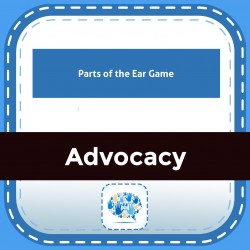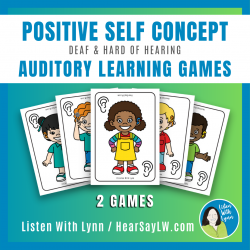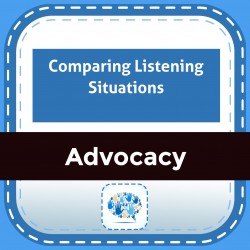Ability Levels
Categories
Resource Types
Age/Grade Range
CCSS
Anchor Standard
Speaking & Listening
Language
Reading
Parts of the Ear Game
$ 5
This is a fun digital learning activity for a student to review the 3 parts of the ear. The learner identifies the function of each part, what is in each part and uses a diagram to identify parts of t
...
he ear.There are very few digital learning activities available today. Advocacy practice for students with hearing loss includes learning about hearing. As students begin to learn how they ear, identifying the 3 parts of the ear is a first step. They need lots of practice labeling different parts of the ear and identifying how they help with hearing. Learning Objective:1. The student will be able to identify functions of the 3 parts of the ear. 2. Given a diagram, the student will label the part of the ear.
Positive Self-Concept Auditory Learning Games
$ 5
If you have kids who are deaf and hard of hearing that need a boost building their CONFIDENCE and SELF-CONCEPT then this resource is a must-have! It helps children feel good about themselves and their
...
hearing technology! The two games also target auditory memory, comprehension, descriptive vocabulary, questioning skills, grammar, and social skills.Colorful playing cards feature 16 children wearing hearing devices like hearing aids, cochlear implants, and bone-anchored hearing systems. It highlights vocabulary like unilateral, bilateral, behind-the-ear, in-the-ear, earmolds, processor, headpiece, magnet, coil, microphone, and more.
Talking and learning about hearing devices prepares kids with resilience and builds appropriate advocacy skills from an early age.
These auditory learning games are FUN for the kids and are a SIMPLE one-time prep GRAB & GO activity for you.
INCLUDES:✧ H-EARS TO YOU - Game 1
Uses differential yes or no questions to listen and isolate a "hidden" game card of a child who is deaf or hard of hearing. (Print version and a Digital version ready to screen share)✧ HEAR! HEAR! - Game 2
Players ask questions and listen to match pairs of children
with hearing loss. (Print)✧ A guide with instructions and potential listening and language outcomes. ✧ Listening and spoken language (LSL) Tips◈ ◈ ◈ ◈ ◈ ◈ ◈ ◈ ◈ ◈ ◈ ◈ ◈ ◈ ◈ ◈ ◈ ◈ ◈ ◈ ◈ ◈ ◈ ◈ ◈ ◈ ◈ ◈ ◈ ◈
CUSTOMER TIPS ➼ Questions? EMAIL ME before purchasing this resource or anytime later ➼ Earn TPT Credit towards your future purchases by leaving a review for this resource.
➼ Follow me to be updated with newbies and freebies! ♥ Sign-up HERE for the Listen With Lynn Emails
♥ Let’s Connect on Instagram and Facebook
Keep up your good work. I am blessed to help along the way.
Thanks so much!
Lynn Wood
Comparing Listening Situations
$ 5
This interactive Google Slides activity asks students to evaluate 4 listening situations (presented in pictures and short descriptions) and rate them on a scale according to listening difficulty. Afte
...
r rating the situations, students are tasked with providing an explanation of why each situation is difficult or easy to hear. This would be a great 'stepping off' activity to begin a unit on coping skills or to evaluate how a student perceives different situations and why/how he/she feels about his/her listening abilities.There is very little digital learning activities available for remote learning today. This tool that asks students to rate situations that are difficult or easy to hear encourages introspection about a student's hearing loss. Asking student to explain why the situation is easy or hard to hear encourages them to evaluate their own listening skills and how advocacy can improve even the most difficult situation.Learning Objective:The student will be able to compare listening situations by rating them on a scale from easy to hear to hear. The student will be able to describe why a specific listening situation is difficult or easy to hear, giving support for their answers.
 Your browser is out of date. For best experience switch to latest updated Browser.
Your browser is out of date. For best experience switch to latest updated Browser.
 Get Chrome
Get Chrome Get Edge
Get Edge Get Firefox
Get Firefox


